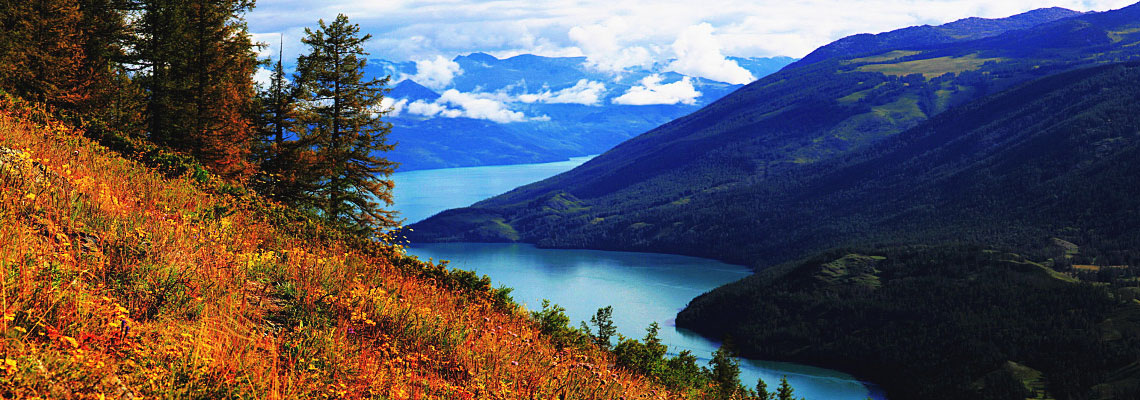
Day 1
Urumqi-

- Xinjiang Museum
We will meet you at the airport, transfer you to the hotel and check you in. If time allows, we will visit the Xinjiang Museum, which can help you to get a general idea about Xinjiang Province. In the afternoon, we will visit the International Bazaar and enjoy the Uyger show.
Xinjiang Museum: The Xinjiang Regional Museum is a large integrated museum and a centre for the collection and study of cultural relics in Xinjiang. The museum was built in 1953, featuring Uighur ethnic internal decor style and has an exhibition hall covering an area of about 7,800 square meters. There are more than 50,000 pieces of various kinds of cultural relics stored in the museum, among them are the ancient mummies represented by the “Loulan Beauty”, manuscripts in Chinese, Karosthi, Qiuci, Yanji, Tibetan, Uighurian and other characters prevailing in ancient western regions of China, as well as silk, wool, cotton and hemp fabrics and folk raiment, etc., all items of great intrigue. The 'Loulan beauty' mummy in particular is a well preserved mummy from 4000 years ago. It still has a reddish brown skin, thick eyelashes, charming large eyes, and long hair.
International Bazaar: Here you will find a bustling market filled with fruits, clothing, crafts, knives, carpets, and almost anything that you can imagine. This is the largest bazaar in Urumqi, and is a place most welcomed by tourists, especially the ladies who will find they can buy some traditional Yugur cosmetics. On Sunday, there are more stalls and more goods to buy than any other day. The old streets around the bazaar are particularly worth seeing.
Day 2
Urumqi-

- Ghost City
After early breakfast, we will drive some 700 km northwards to Burqin, and visit “Wurhe Ghost City” on the way.
Ghost City: This is the most beautiful Yardan landform in the region. The movie “Crouching Tiger, Hidden Dragon” likely has left you a deep impression of the multi-colored bay where the heroine Ziyi was hidden. The special desert scene shot in the movie is located here at the Gobi desert, about 220 kilometers from Fuyun county of Xinjiang.
Day 3
Burqin-
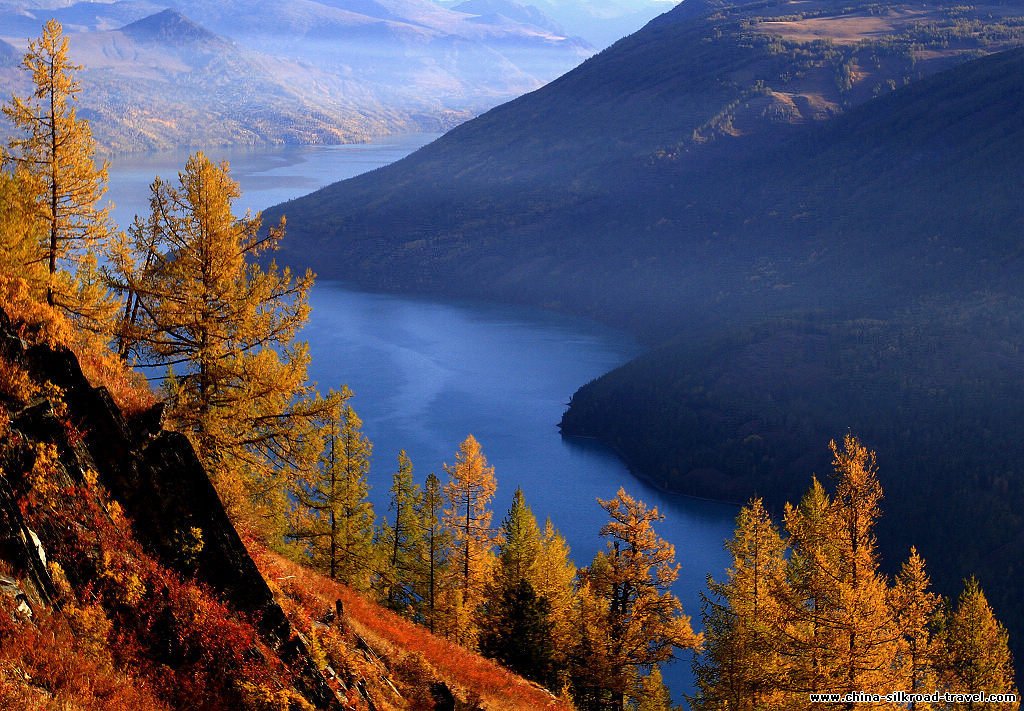
- Kanas Lake
In the morning we will do some shopping for our trekking. Then we will head to Jiadengyu life area, and check into the hotel. After lunch we will enjoy the beautiful view around the lake. We will also take the boat cruise on the lake, where we might even see the monster of the lake.
Kanas Lake: This is the latest lake that has been opened to all tourists in China, and has rapidly attained a reputation as “the tourism pearl of Mountain Altai”. The lake takes on different colors following the four seasons of the year. Sometimes it's crystal blue, sometimes it's dark green, or even gray, you may find it containing many colors setting off each another at a time. It has thus gotten the name the Color-Changing Lake.
Day 4
Kanas Natural Reservation-
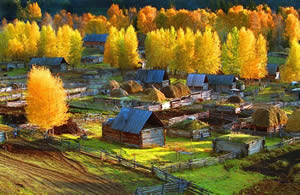
- Hemu Village
After breakfast we will drive about 80 km to Hemu Village. We will enjoy some free time riding horses and experiencing the local folklore. We will enjoy the beautiful sunset view there as well.
Hemu Village: This is one of the three residences of the Tuva Mongol in China. The Tuva Mongol is believed to have descended from the troops of Genghis Khan when he crusaded west. The Tuva Mongol of Hemu Village live in frame houses half-buried in the ground to resist the cold of winter. They believe in Buddhism and have well preserved the traditional beliefs of their tribe. Religious and traditional festivals are always jolly and busy, while the landscape tempts every visitor to come back to experience the wildness of nature.
Day 5
Hemu-
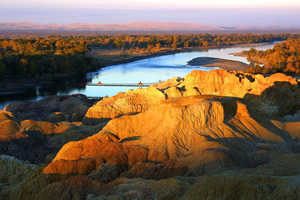
- Five colored Bay
After breakfast we will do some trekking along the village and take photos if you wish to. We will return to Burqin county to have lunch, and then visit the Five-Colored Bay in the sunset, the ideal place and time for photographers. After that you will be transferred to the and then you will be transferred to the Kanas airport and take the flight to Kashgar via Urumqi airport.
Five-Colored Bay: An interesting spot with Yadan landform on one side of Irtysh River yet oasis on the other side. Irtysh River is the only westward flowing river of China.
Day 6
Kashgar-

- Karakul Lake
After breakfast we will drive on the China and Pakistan highway, Karakorum Highway, to visit the Karakul Lake and enjoy the Pamir landscape.
Karakorum Highway: The Karakorum Highway, or China-Pakistan Friendship Highway, is more than 1200 km long. It was opened to the public in 1979. Due to its high elevation (more than 4700m at its highest point) and the difficult conditions in which it was constructed, it is often called the 8th Wonder of the World. The Karakorum Highway traces one of the ancient Silk Roads. The Silk Road merchants then had to climb through the Wakhan Corridor, north of the high mountains of Karakorum and Hindu Kush, to get to India, Pakistan and onward to Iran. While you are on the Karakorum Highway, you can enjoy the scenery of Mt. Muztagh, and Taxkorgan, which in Persian language means stone castle. The brave Tajiks people had lived their nomadic life in Taxkorgan on the Pamir Plateau for more than 2000 years.
Karakul Lake: At an altitude of 3600m, this is the highest lake of the Pamir plateau, near the junction of the Pamir, Tianshan (Heavenly Mountain), and Kunlun Mountain ranges. Surrounded by mountains which remain snow-covered throughout the year, the three highest peaks visible from the lake are the Muztag Ata (7546m), Konur Tagh (7649m) and Kongur Tiube (7530m). The lake is popular among travelers for its beautiful scenery and the clarity of its reflection in the water, whose color ranges from a dark green to azure and light blue. There are two Kirgiz settlements along the shore of Karakul Lake, a number of yurts about 1 km east of the bus drop-off point and a village with stone houses located on the western shores.
Day 7
Kashgar city sightseeing-

- Sunday Bazaar
Today we will visit Sunday Bazaar, Id Kah Mosque, Old Town, Apak Hoja Tomb, Handicraft Street.
Sunday Bazaar: This is called “Sunday” bazaar but it is open daily, even though it is busiest on Sundays. Streets near this big market are jammed with farmers and buyers arriving by donkey cart, truck, bicycle, horseback, ute, motobike, or on foot, with their animals. It is loud, lively and cheerful as they arrive, eat breakfast, set up their animals and check out the action. Cattle, sheep (they definitely look different), goats, donkeys, horses have their own sections. Sellers show off their animals as “good eaters” (most go as livestock, not meat). The entire experience is fascinating and fun.
Id Kah Mosque: This is the largest mosque in China, and the most famous mosque in Xinjiang. The construction of the mosque started in the middle of the 15th century, and the mosque has gradually developed to its present size. The buildings of Id Kah Mosque look magnificent and solemn, and display the artistic styles of Islamic mosque architecture. The Mosque has an area of about 16,800 square meters, consisting of the Pray Hall, the Koran teaching Hall, the Corridor, the Arches and other buildings attaching to it. The Pray Hall of the mosque, which can hold 4,000 prayers, is supported by 140 carved wooden pillars.
Old Town: Kashgar is an ancient city, and in walking the streets of its Old Town, one gets the sense of what this legendary Central Asian hub was like in the days when the Silk Road was at its zenith. 500-year old remnants of the city wall, narrow lanes and colorful multi-ethnic crowds combine to make Kashgar’s historic district a highlight of any visit to the city. Visit the small alleys to look at the characteristic Uygur residences. You will experience and enjoy the culture and history that has been retained in the small alleys and deep courtyards. In the alleys on platforms beside the residence you could marvel at the even more ancient primitive workshops for hand-made earthenware. Some 17 or 18 antique workshops have been restored.
Handicraft Street: Handicraft Street, or Zhiren Street, is a fascinating place showing the distinctive custom and culture of Kashgar, with many full-time handicraftsmen working on the street and hundreds of workshops and booths alongside. This street is an exhibition for traditional Kashgar and mid-Asian handicrafts. Copper, metal, porcelain, woodwork, jewellery and other goods are seen to be made here and you will marvel at the incredible devices like the wooden objects that prevent babies from wetting the bed.
Day 8
Kashgar-

- Karez Irrigation System
After breakfast you will take the flight to Urumqi and then head to Turpan, check into the hotel, and then we will visit Jiaohe Ruined city, Karez Irrigation system, Sugong Minaret.
Jiaohe Ancient City Ruins: The city's name means 'River City'. It was founded during the first century BC and abandoned during the 15th century. It is located atop a steep cliff on a leaf-shaped plateau between two deep river valleys in the Yarnaz valley 10 km to the west of Turpan City. It runs northwest to southeast, 1760 meters long and 300 meters across at the widest part. The ruins include city gates, streets and lanes, government office, temples, domestic houses, cave houses, wells, and an underground temple. It is part of the UNESCO World Heritage Silk Road Sites.
Karez Irrigation System: The ancient Karez Irrigation System, which is still used today, is a unique irrigation system in Turpan. It takes advantage of the slopes, draws the underground water to flow by itself to irrigate farmland. It consists of four parts: vertical wells, underground channels, ground canals, and small reservoirs.
Sugong Minaret: Located in Mura Village 2km to the east of the city of Turpan, the minaret tower was built in the 41st year of the long reign of Qianlong Emperor during the Qing Dynasty. It is the embodiment of the ancient architectural arts of the Uighur people. The body of the tower is cylindroid in shape, built with bricks arranged in various symmetrical patterns on the outer wall. The tower has 14 windows and a spiral staircase inside going to the top.
Day 9
Turpan-
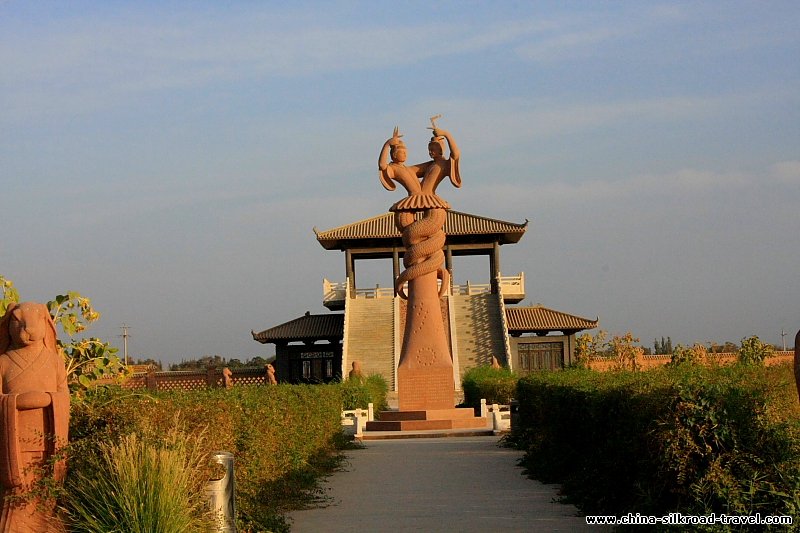
- Astana Tombs
After breakfast we will visit Tuyoq Valley. Astana Tombs, The Flaming Mountain, and then after dinner you will take the soft sleeper train to Dunhuang.
Tuyoq Valley: This is a 12 km long primitive Uighur agricultural valley about 70 km from Turpan, with vineyards and fields in the northern and southern valleys and a narrow ravine that connects them. It is a Muslim religious pilgrimage site. The southern mouth of the valley has big Uighur mosques older than the Sugong Minaret and a cave thought by many to be described in the Koran. About a kilometer from the cave shrine is a group of grottoes that have some Buddhist and Nestorian artwork. These grottoes are said to date from the West Jin Dynasty (265AD-316AD), and are considered to be the earliest in Turpan. Most of the murals are damaged. Fortunately, 10 of the grottoes still have some of the preserved murals. These precious murals are very unique in style.
Astana Tombs: This is the graveyard of the residents who lived in the Gaochang City in the Jin-Tang period. Between 1959 and 1975, a great number of cultural relics had been unearthed, including Chinese documents, textiles, epitaphs, coins, clay sculptures, pottery, wooden wares, silk-paintings, crops and foods, etc. The site is known as the Underground Museum.
The Flaming Mountain: The Flaming Mountain is famously described in the classic Chinese mythological novel “Journey to the West”. It runs west from Shanshan County, is 98 km in length and 9 km across, with a relative height of 500 meters and the highest peak at 832 meters. The mountain is a branch range of the Bogda Mountain, formed in the orogenic movements of the Himalayas. This is the hottest place in China. The highest air temperature in summer is 47.8 degrees Centigrade, and the ground is over 70 degrees Centigrade in summer. Many years of volcanic activity have formed the unique crisscrossing gullies and ravines. During mid-afternoon the heat becomes intense as the sun's rays are reflected off the red rocks, as though the hillsides are engulfed by tongues of fire, hence the name.
Day 10
Dunhuang-

- Mogao Grottoes
We will meet you at the train station, transfer you to the hotel and check you in. After breakfast we will visit the famous Mogao Grottoes, and then in the afternoon we will visit the Echoing-Sand Mountain and Crescent Moon Spring.
Mogao Grottoes: The Mogao Grottoes, a shrine of Buddhist art treasures, is 25 km from downtown Dunhuang on the eastern slope of Mingsha Shan (Echoing Sand Mountain). A network of plank-reinforced roads plying north to south 1600 meters long lead to the cave openings, which are stacked five stories high, some reaching up to 50 meters. Incidentally, Mogao means high up in the desert. According to Tang Dynasty records, a monk had witnessed onsite a vision of thousand Buddhas under showers of golden rays. Thus inspired, he started the caves construction work that spanned a millennium, from the 4th to the 14th centuries. What remains today is truly awe inspiring, and is likely the world’s richest treasure house of Buddhist sutras, murals and sculptures. Please note that cameras are not allowed inside the grottoes.
Echoing-Sand Mountain and Crescent Lake: Together with the Crescent Spring and the Mogao Caves, the Echoing-Sand Mountain is the most popular tourist site in Dunhuang. Echoing-Sand Mountain, known as Mingsha Mountain to the Chinese, is 5 km to the south of Dunhuang and is famous for the constant sound of the moving sand. Legend has it that many years ago a horrific battle was fought here, and the sounds we hear today were the haunting cries of soldiers buried in the sand dunes. Situated within the Echoing-Sand Mountain Park, the Crescent Moon Lake is literally an oasis in the desert. The lake’s name derives from the crescent moon shape taken by the pool of spring water between two large sand dunes. Although the surrounding area is very dry, the pool surprisingly doesn’t dry up as one might expect.
Day 11
Dunhuang-

- Yulin Grottoes
After breakfast we will drive to Jiayuguan, and we will visit Yulin Grottoes on the way. Upon arrival in Jiayuguan, we will visit The Great Wall on the Cliff.
Yulin Grottoes: The Yulin Grottoes lie 70 km to the south of Anxi County, Gansu Province. The Grottoes are chiseled into the cliffs on both the east and west sides of the Yulin River. The east cliff has 30 grottoes and the west has 11, with a distance of more than 100 meters between them. It used to be called Ten-Thousand Buddha Gorge. The grottoes began to be chiseled and sculpted during the Northern Wei Dynasty (386-534), and was enlarged in the later dynasties, such as Tang (618-907), Five Dynasties (907-960), Song (960-1279), the Western Xia (1038-1227), Yuan (1271-1368) and so on. More than 1,000 square meters of frescoes, and more than 100 colored sculptures are still extant there. The name Yulin (elm forest) came from the elms in the valley, and as you travel along the valley road you can easily imagine how it must have been to be a poet or brave solder in the distant past.
The Great Wall on the Cliff: The Suspended Wall is a part of the Great Wall of China. The wall here was built on the ridge with a gradient of 45 degrees. It is high in the air and it looks as if it fell down from the top of the hill. So people refer to this section of the Great Wall as the "Suspended Wall". The Suspended Wall, the extension of the walls at the Jiayuguan Pass towards the north, was an integral part of the ancient defense system at the Jiayuguan Pass.
Day 12
Jiayuguan-

- The Jiayuguan Pass
In the morning we will visit The Jiayuguan Pass, Weijin Tomb, and Great Walls Museum. After lunch you will take the flight to Xi'an. We will meet you at the airport, transfer you to the hotel and check you in.
Jiayuguan Pass: Jiayuguan Pass stands in the southwest part of Jiayuguan City, about 6 km away from downtown. The Ming Dynasty fort here guards the strategic pass, at the western end of the Great Wall – this was the last section built by the Ming Dynasty. Construction of the fort was started in 1372 in the Ming Dynasty, and subsequently enlarged and strengthened, and was known as 'the strongest pass under heaven'. It is located in the Jiayu Highland, hence its name Jiayuguan. It is situated between the Wenshu and Heishan Mountains at the foot of Jiayuguan Hill of the Qilian Mountain range.
Weijin Tomb: About 15 kilometers northeast of Jiayuguan, there are over 1,400 tombs which were built during the Wei and Jin dynasties (between the 3rd and 5th century). They feature brick wall paintings showing various social activities of the times.
Great Wall Museum: The Great Wall museum opened to visitors in October 1989, and it is the first museum to exhibit the Great Wall culture in a comprehensive and systematic way. The Museum covers an area of 12,312 square meters with an exhibition area of about 1,766 square meters. Its main building takes a shape of a typical signal fire tower on the Great Wall.
Day 13
Xi'an-

- Terra-cotta Warriors and Horses
We will visit the famous Terra-cotta Warriors and Horses, the Bell Tower and the Wild Goose Pagoda, and enjoy the Tang Dynasty show in the evening.
The Terra-cotta Warriors and Horses: This is one of the greatest archaeological findings of the 20th century - the army of terra-cotta warriors and the bronze chariots entombed in vast underground vaults at emperor Qin Shi Huang's tomb from two thousand years ago. It is a sight not to be missed by any visitor to China. Emperor Qin Shi Huang ascended to the throne of Qin at the age of 13 in 246 BC. Under him, Qin conquered the other six warring states and became the first true emperor, or Shi Huang, of China.
The Bell Tower: This is the emblem of Xian city. It was used to keep time for the town and to sound alarms. This huge tower was originally built in the 14th century, and was relocated in 1739.
Big Wild Goose Pagoda: The Big Goose Pagoda is where the renowned Buddhist Master Xuanzang (Monk Tripitaka) stored his classics brought back all the way from India. The pagoda is one of the oldest structures in China. Originally it consisted of a brick structure of five storeys and was about 60 meters high. It was first built in 589AD during the Sui Dynasty. Between 701AD and 704AD during the reign of the Empress Wu Zetian five more storeys were added to the pagoda making it ten in all.
The Tang Dynasty show: The show that presents the palace dances and sings in the Tang Dynasty when Xian was the capital.
Day 14
xi'an-

- The Ancient City Wall
We will visit Shaanxi History Museum, Xian City Wall, and The Grand Mosque. The Provincial Museum: and the rest of the day is for you free.
Shaanxi History Museum: This provincial museum is one of the major museums in China, and it holds numerous unearthed cultural artifacts from within the Shaanxi province as well as the rest of China.
The Ancient City Wall: This is an extension of the old Tang Dynasty structure boasting the most complete city wall that has survived through the long Chinese history. The City Wall has corner towers, ramparts, sentry towers, gate towers, battlements and a number of city defensive fortifications with very strong defense capability.
Day 15
Xi'an
| Travel in party of |
Superior Class ★★★★★ |
Deluxe Class ★★★★ |
Tourist Class ★★★ |
| 2-5 persons | N | $ | $ |
| 6-9 persons | N | $ | $ |
| 10 persons & above | N | $ | $ |
| Single room Supplement | N | $ | $ |
Service included:
√ Personal Guide & Driver + Private car / van for Private Transfers & sightseeing
√ Hotels (twin share bases) as listed in the itinerary
√ Domestic flights or trains as listed in the itinerary
Flights: Kanas to Urumqi, Urumqi to Kashgar return, Jiayuguan to Xi'an
Train (soft Sleeper) Turpan to Dunhuang
√ Airport Taxes: US$30 for domestic
√ Service Charge & Government Taxes
√ Luggage Transfers between airports and hotels
Service excluded:
* Personal expenses. such as laundry and tips to the guide and driver
* Other activities such as boating, camel riding etc.

